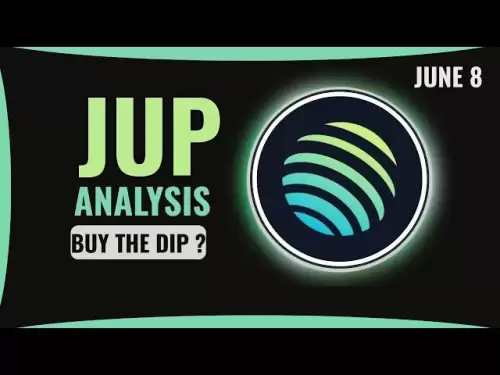-
 Bitcoin
Bitcoin $105,570.7249
0.61% -
 Ethereum
Ethereum $2,514.8294
0.97% -
 Tether USDt
Tether USDt $1.0005
-0.02% -
 XRP
XRP $2.2169
1.43% -
 BNB
BNB $650.3846
0.18% -
 Solana
Solana $150.1555
-1.02% -
 USDC
USDC $0.9999
0.00% -
 Dogecoin
Dogecoin $0.1841
-0.27% -
 TRON
TRON $0.2855
2.71% -
 Cardano
Cardano $0.6641
-0.51% -
 Hyperliquid
Hyperliquid $35.0211
2.57% -
 Sui
Sui $3.2237
-1.55% -
 Chainlink
Chainlink $13.7992
-1.35% -
 Avalanche
Avalanche $20.3403
-0.25% -
 UNUS SED LEO
UNUS SED LEO $9.2755
2.19% -
 Stellar
Stellar $0.2672
0.69% -
 Bitcoin Cash
Bitcoin Cash $410.1623
2.19% -
 Toncoin
Toncoin $3.1609
-0.78% -
 Shiba Inu
Shiba Inu $0.0...01259
-1.50% -
 Hedera
Hedera $0.1683
0.22% -
 Litecoin
Litecoin $87.9512
-0.11% -
 Polkadot
Polkadot $4.0492
0.92% -
 Monero
Monero $336.5887
3.38% -
 Ethena USDe
Ethena USDe $1.0012
-0.03% -
 Bitget Token
Bitget Token $4.6762
0.07% -
 Dai
Dai $0.9999
0.00% -
 Pepe
Pepe $0.0...01147
-0.74% -
 Pi
Pi $0.6298
0.33% -
 Uniswap
Uniswap $6.2792
1.86% -
 Aave
Aave $254.6353
0.71%
How to interpret the KDJ golden cross? What does the death cross formation mean?
The KDJ indicator, used in crypto trading, signals potential buys with a golden cross and sells with a death cross, enhancing informed trading decisions.
Jun 06, 2025 at 11:01 pm
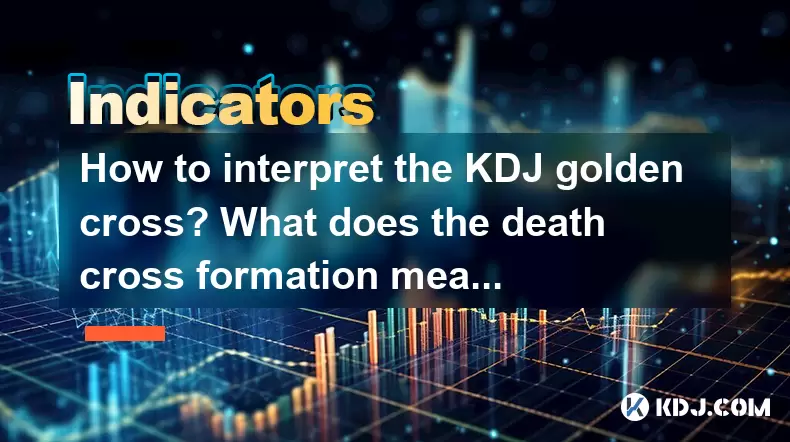
The KDJ indicator, also known as the Stochastic Oscillator, is a popular technical analysis tool used in the cryptocurrency trading community to identify potential buy and sell signals. Understanding the nuances of the KDJ golden cross and the death cross formation can significantly enhance a trader's ability to make informed decisions. This article will delve into the details of these two critical patterns, providing a comprehensive guide on how to interpret them within the context of cryptocurrency trading.
What is the KDJ Indicator?
The KDJ indicator is a momentum oscillator that measures the relative position of the closing price within a given period's price range. It consists of three lines: the K line, the D line, and the J line. The K and D lines are the primary components used for identifying the golden cross and death cross formations.
- K Line: This line represents the fast-moving average of the stochastic oscillator.
- D Line: This line is the slow-moving average, calculated as a moving average of the K line.
- J Line: This is an additional line, calculated as 3K - 2D, which can be used to confirm signals from the K and D lines.
The KDJ indicator oscillates between 0 and 100, with readings above 80 indicating overbought conditions and readings below 20 indicating oversold conditions.
Understanding the KDJ Golden Cross
The KDJ golden cross is a bullish signal that occurs when the K line crosses above the D line. This crossover suggests that the momentum is shifting from bearish to bullish, indicating a potential buying opportunity.
To identify a KDJ golden cross, follow these steps:
- Monitor the K and D Lines: Observe the movement of the K and D lines on your trading chart.
- Identify the Crossover: Look for the moment when the K line crosses above the D line.
- Confirm the Signal: Ensure that the crossover occurs in an oversold region (below 20) to increase the reliability of the signal.
When the KDJ golden cross occurs in an oversold region, it suggests that the cryptocurrency's price may have reached a bottom and is likely to rebound. Traders often use this signal as a trigger to enter long positions.
Interpreting the KDJ Death Cross
Conversely, the KDJ death cross is a bearish signal that occurs when the K line crosses below the D line. This crossover indicates a shift in momentum from bullish to bearish, suggesting a potential selling opportunity.
To identify a KDJ death cross, follow these steps:
- Monitor the K and D Lines: Keep an eye on the movement of the K and D lines on your trading chart.
- Identify the Crossover: Look for the moment when the K line crosses below the D line.
- Confirm the Signal: Ensure that the crossover occurs in an overbought region (above 80) to increase the reliability of the signal.
When the KDJ death cross occurs in an overbought region, it suggests that the cryptocurrency's price may have reached a peak and is likely to decline. Traders often use this signal as a trigger to enter short positions or to exit existing long positions.
Using the J Line for Confirmation
While the K and D lines are the primary components for identifying golden and death crosses, the J line can provide additional confirmation of these signals.
- J Line Confirmation for Golden Cross: After identifying a KDJ golden cross, check if the J line is also moving upwards. A rising J line can reinforce the bullish signal.
- J Line Confirmation for Death Cross: After identifying a KDJ death cross, check if the J line is also moving downwards. A falling J line can reinforce the bearish signal.
Using the J line as a confirmation tool can help traders increase the accuracy of their trading decisions based on the KDJ indicator.
Practical Example of KDJ Golden and Death Crosses
To illustrate the practical application of the KDJ golden and death crosses, let's consider a hypothetical example involving Bitcoin (BTC).
Golden Cross Example: Suppose the price of BTC has been declining and the KDJ indicator shows the K and D lines in the oversold region (below 20). Suddenly, the K line crosses above the D line, forming a golden cross. The J line also starts to rise, confirming the bullish signal. Based on this, a trader might decide to enter a long position on BTC, anticipating a price rebound.
Death Cross Example: Now, suppose the price of BTC has been rising and the KDJ indicator shows the K and D lines in the overbought region (above 80). Suddenly, the K line crosses below the D line, forming a death cross. The J line also starts to fall, confirming the bearish signal. Based on this, a trader might decide to enter a short position on BTC or exit an existing long position, anticipating a price decline.
Combining KDJ with Other Indicators
While the KDJ indicator is powerful on its own, combining it with other technical analysis tools can enhance its effectiveness. Some popular indicators to use alongside the KDJ include:
- Moving Averages: Using moving averages can help confirm trends identified by the KDJ indicator. For example, a golden cross on the KDJ combined with a bullish crossover of short-term and long-term moving averages can provide a strong buy signal.
- Relative Strength Index (RSI): The RSI can help confirm overbought and oversold conditions identified by the KDJ. A KDJ golden cross in an oversold region confirmed by an RSI reading below 30 can be a robust buy signal.
- MACD (Moving Average Convergence Divergence): The MACD can help confirm momentum shifts identified by the KDJ. A KDJ death cross in an overbought region confirmed by a bearish MACD crossover can be a strong sell signal.
Potential Pitfalls and Considerations
While the KDJ golden and death crosses can be valuable tools for cryptocurrency traders, there are several potential pitfalls and considerations to keep in mind:
- False Signals: Like all technical indicators, the KDJ can generate false signals. It's essential to use additional confirmation tools and consider the broader market context before acting on a KDJ signal.
- Volatility: Cryptocurrencies are known for their high volatility, which can lead to frequent and rapid changes in the KDJ indicator. Traders should be cautious and use appropriate risk management strategies.
- Time Frame: The effectiveness of the KDJ indicator can vary depending on the time frame used. Shorter time frames may generate more signals but can also be less reliable, while longer time frames may provide more reliable signals but fewer trading opportunities.
Frequently Asked Questions
Q: Can the KDJ indicator be used for all cryptocurrencies?
A: Yes, the KDJ indicator can be applied to all cryptocurrencies. However, the effectiveness of the indicator may vary depending on the specific cryptocurrency's volatility and trading volume. It's crucial to backtest the indicator on historical data for each cryptocurrency to understand its performance better.
Q: How often should I check the KDJ indicator for signals?
A: The frequency of checking the KDJ indicator depends on your trading strategy and time frame. For short-term traders, checking the indicator multiple times a day might be necessary. For long-term traders, checking the indicator less frequently, such as daily or weekly, may be more appropriate.
Q: Are there any specific settings for the KDJ indicator that work best for cryptocurrencies?
A: The default settings for the KDJ indicator are typically set to 9, 3, and 3 for the periods of the K, D, and J lines, respectively. These settings can be effective for cryptocurrencies, but traders may need to adjust them based on their specific trading strategy and the cryptocurrency's volatility. Experimenting with different settings and backtesting can help find the most suitable configuration.
Q: Can the KDJ indicator be used in conjunction with fundamental analysis?
A: Yes, combining the KDJ indicator with fundamental analysis can provide a more comprehensive view of a cryptocurrency's potential. While the KDJ focuses on technical momentum, fundamental analysis can help assess the underlying value and long-term prospects of a cryptocurrency. Using both approaches together can lead to more informed trading decisions.
Disclaimer:info@kdj.com
The information provided is not trading advice. kdj.com does not assume any responsibility for any investments made based on the information provided in this article. Cryptocurrencies are highly volatile and it is highly recommended that you invest with caution after thorough research!
If you believe that the content used on this website infringes your copyright, please contact us immediately (info@kdj.com) and we will delete it promptly.
- RTX Could Beat XRP by Delivering 5880% Upsurge
- 2025-06-08 15:15:12
- Bitcoin Pepe (BPEP) Aims to Merge Bitcoin's Brand Recognition with Meme Coins' Market Momentum
- 2025-06-08 15:15:12
- XRP Price Drops as It Marks Its Fifth Consecutive Session of Losses
- 2025-06-08 15:10:13
- On Its 7th Anniversary, MEXC Exchange Announces a Series of Future-Focused Initiatives
- 2025-06-08 15:10:13
- FOMC Meeting This Week: Semler Scientific Leads Way on BTC Corporate Treasuries
- 2025-06-08 15:05:12
- USDe Stablecoin Takes Center Stage
- 2025-06-08 15:05:12
Related knowledge
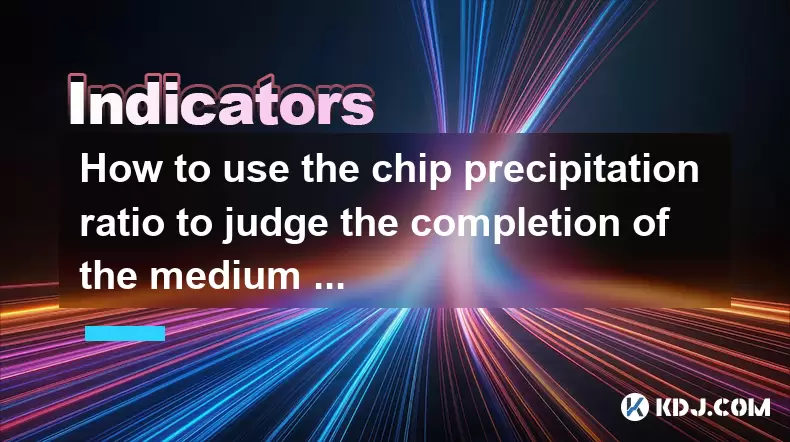
How to use the chip precipitation ratio to judge the completion of the medium and long-term bottom construction?
Jun 04,2025 at 03:36am
The chip precipitation ratio is a crucial metric used by investors to assess the accumulation of chips (or shares) at different price levels over time. This ratio helps in understanding the distribution of chips and can be a powerful tool for determining the completion of medium and long-term bottom construction in the cryptocurrency market. By analyzin...
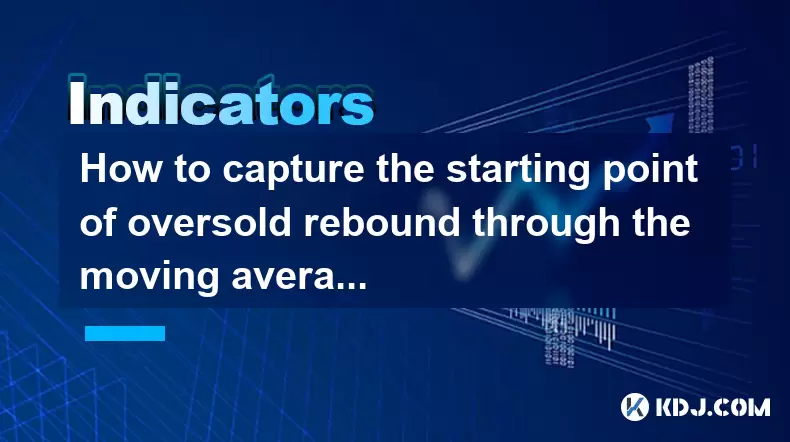
How to capture the starting point of oversold rebound through the moving average gravity reversal strategy?
Jun 04,2025 at 01:01pm
The moving average gravity reversal strategy is a sophisticated approach used by traders to identify potential entry points for buying cryptocurrencies when they are considered oversold. This strategy leverages the concept of moving averages to pinpoint moments when a cryptocurrency might be poised for a rebound. In this article, we will delve into the ...
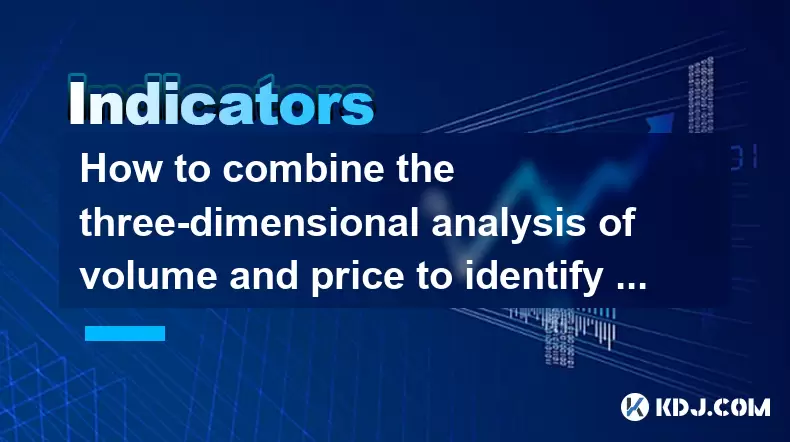
How to combine the three-dimensional analysis of volume and price to identify the golden buying point of breakthrough and retracement?
Jun 03,2025 at 11:42pm
In the dynamic world of cryptocurrencies, identifying the optimal buying points is crucial for maximizing profits and minimizing risks. One effective method to achieve this is by combining three-dimensional analysis of volume and price to pinpoint the golden buying points during breakouts and retracements. This article will delve into how to use this ap...
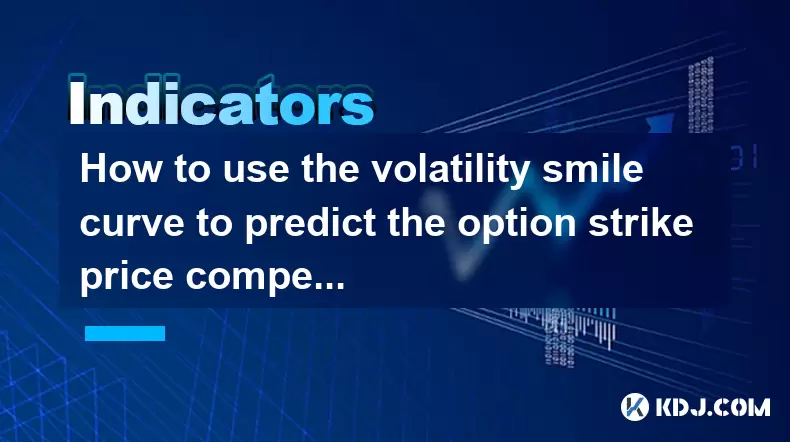
How to use the volatility smile curve to predict the option strike price competition area?
Jun 06,2025 at 01:01pm
The volatility smile curve is a graphical representation that shows the implied volatility of options across different strike prices for a given expiration date. It is called a 'smile' because the curve often takes the shape of a smile, with higher implied volatilities for options that are deep in-the-money or deep out-of-the-money, and lower implied vo...
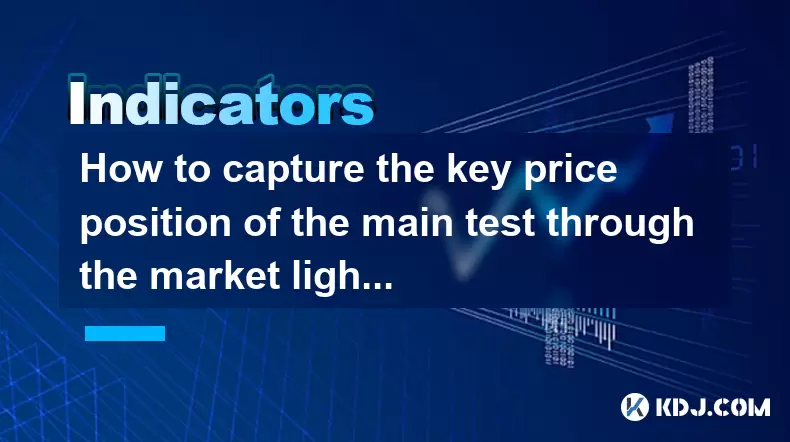
How to capture the key price position of the main test through the market lightning chart?
Jun 02,2025 at 06:07pm
Introduction to Market Lightning ChartThe market lightning chart is a powerful tool used by cryptocurrency traders to visualize price movements and identify key price positions. This chart type provides a detailed view of market activity, allowing traders to spot trends, reversals, and other significant price levels quickly. By understanding how to use ...
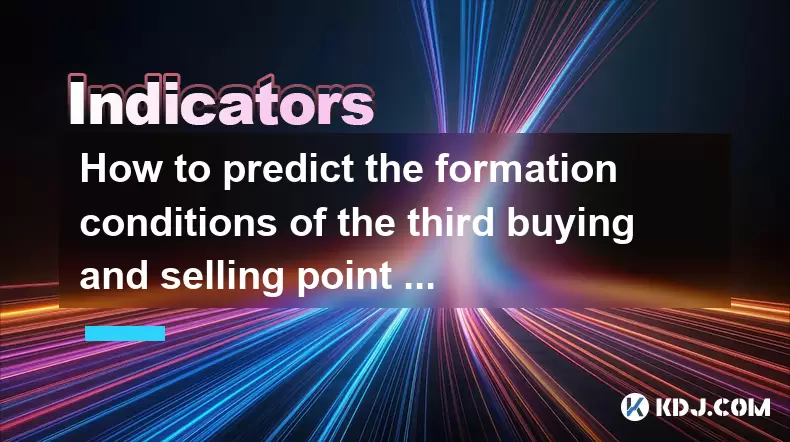
How to predict the formation conditions of the third buying and selling point in combination with the extension of the central axis of the Chaos Theory?
Jun 08,2025 at 12:42am
The concept of predicting the formation conditions of the third buying and selling point in the cryptocurrency market by combining the extension of the central axis of the Chaos Theory is an advanced analytical technique. This method involves understanding the chaotic nature of price movements and using it to identify key moments for trading. In this ar...

How to use the chip precipitation ratio to judge the completion of the medium and long-term bottom construction?
Jun 04,2025 at 03:36am
The chip precipitation ratio is a crucial metric used by investors to assess the accumulation of chips (or shares) at different price levels over time. This ratio helps in understanding the distribution of chips and can be a powerful tool for determining the completion of medium and long-term bottom construction in the cryptocurrency market. By analyzin...

How to capture the starting point of oversold rebound through the moving average gravity reversal strategy?
Jun 04,2025 at 01:01pm
The moving average gravity reversal strategy is a sophisticated approach used by traders to identify potential entry points for buying cryptocurrencies when they are considered oversold. This strategy leverages the concept of moving averages to pinpoint moments when a cryptocurrency might be poised for a rebound. In this article, we will delve into the ...

How to combine the three-dimensional analysis of volume and price to identify the golden buying point of breakthrough and retracement?
Jun 03,2025 at 11:42pm
In the dynamic world of cryptocurrencies, identifying the optimal buying points is crucial for maximizing profits and minimizing risks. One effective method to achieve this is by combining three-dimensional analysis of volume and price to pinpoint the golden buying points during breakouts and retracements. This article will delve into how to use this ap...

How to use the volatility smile curve to predict the option strike price competition area?
Jun 06,2025 at 01:01pm
The volatility smile curve is a graphical representation that shows the implied volatility of options across different strike prices for a given expiration date. It is called a 'smile' because the curve often takes the shape of a smile, with higher implied volatilities for options that are deep in-the-money or deep out-of-the-money, and lower implied vo...

How to capture the key price position of the main test through the market lightning chart?
Jun 02,2025 at 06:07pm
Introduction to Market Lightning ChartThe market lightning chart is a powerful tool used by cryptocurrency traders to visualize price movements and identify key price positions. This chart type provides a detailed view of market activity, allowing traders to spot trends, reversals, and other significant price levels quickly. By understanding how to use ...

How to predict the formation conditions of the third buying and selling point in combination with the extension of the central axis of the Chaos Theory?
Jun 08,2025 at 12:42am
The concept of predicting the formation conditions of the third buying and selling point in the cryptocurrency market by combining the extension of the central axis of the Chaos Theory is an advanced analytical technique. This method involves understanding the chaotic nature of price movements and using it to identify key moments for trading. In this ar...
See all articles

























